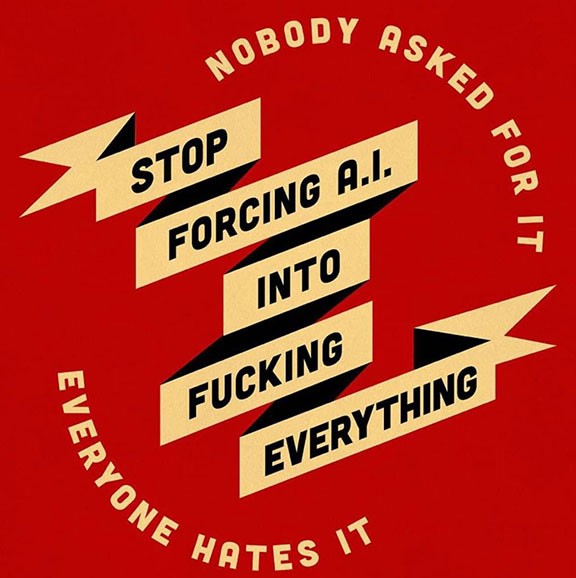Recent Posts
-
Real Crimes and the Coming Violence
September 6, 2025
-
Whither Modern Life?
June 27, 2025
-
What the Hell
June 18, 2025
-
As Darkness Engulfs Us
April 6, 2025
-
AI, Risk, and Work
January 17, 2025
-
“Things Are in the Saddle, and Ride Mankind”
December 29, 2024
-
Forgotten Futures in Seattle
December 12, 2024
-
Autocracy Defeats Neoliberalism
November 14, 2024
-
History… We’re Soaking in It!
October 2, 2024
-
A Numbing Spectacle
September 22, 2024
|
I’ve been AWOL from this blog for months now. My dad moved into an assisted living facility in Millbrae and it’s been very time-consuming, to say the least. I had all sorts of problems with his health, the institution and its billing practices, and all the planning associated with leaving his home, watching my sister and brother-in-law get ready to relocate to the midwest, and organizing the imminent sale of his house. I think it’s starting to settle down now, and I’m hoping for a regular rhythm that will leave me some time to process my thoughts and perhaps occasionally share them here as I am wont to do…
Here’s the first of the placards I made for yesterday’s nationwide protests. It was good to be out in the sun with friends. It was a funny milling-about kind of demonstration, which was fine with me. I was far from the stage and the official speechifying, something I never care for anyway. I also attended briefly the “Tesla Takedown” rally in front of the dealership on Van Ness a week earlier, so I’ll pepper this with images from that too.
 My first sign for the April 5 protest. 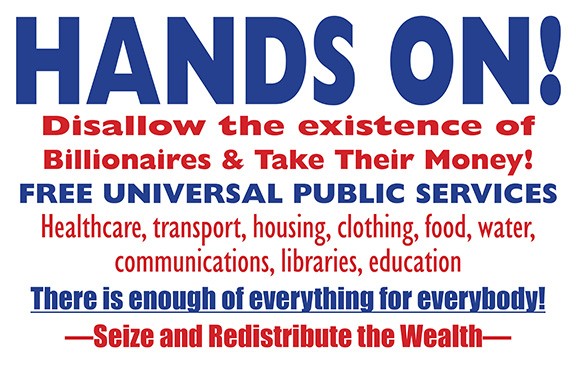 Rather than “hands off” all sorts of dumb things like NATO, I say “hands on” because we have some obvious changes to make… But I thought I’d use this moment to post a short screed I wrote to accompany a link to the public statement by the OAH and AHA, the two main history organizations in the country.
In brazenly trying to put the (critical historical scholarship) toothpaste back into the tube (of social amnesia and self-congratulatory denial), the neo-fascists running the organized demolition of the administrative state attempt the impossible. Far too many deeply researched and brilliantly written works have appeared in the last half century, all contributing to a far more nuanced and critical understanding of the settler colonial society that is the United States of America, founded on slavery and genocide, and designed to reinforce white supremacy at every opportunity. As the two main historical organizations representing working historians argue, “Classifying collective historical scholarship as ‘toxic indoctrination’ or ‘discriminatory equity ideology’ dismisses the knowledge generated by the deep research of generations of historians.”
The book burning bonfires may not be far off, since the free circulation of books remains one of the most effective means of subverting the blathering, blatantly false propaganda being imposed by executive fiat. Let’s conserve and share our libraries, let’s do what we can to keep a bright flame of critical historical thinking burning. Perhaps one day the fires we kindle will overwhelm the puny minds trying so desperately to silence the winds of change that have already scoured the land and buried forever the old cliches of American history.
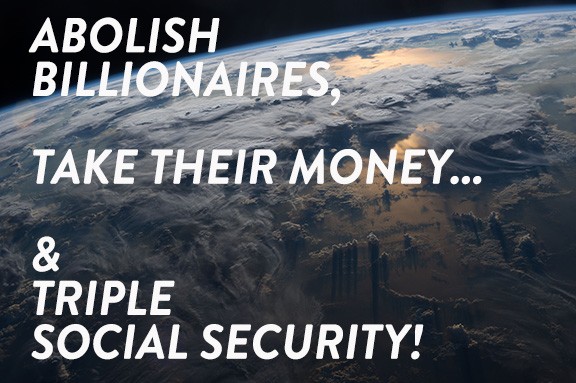 The view from the International Space Station! 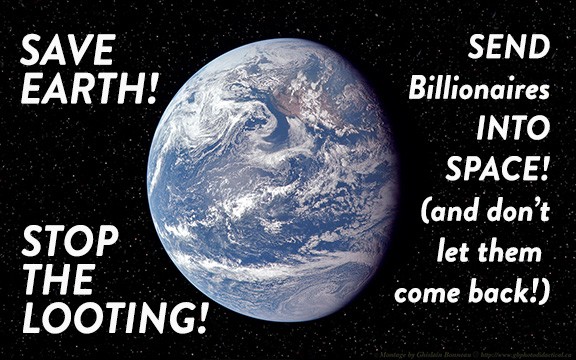 Even further out there… And from the Tesla Takedown protest on March 29…
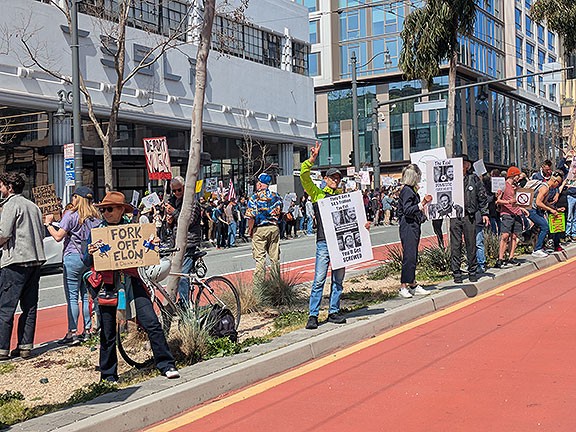
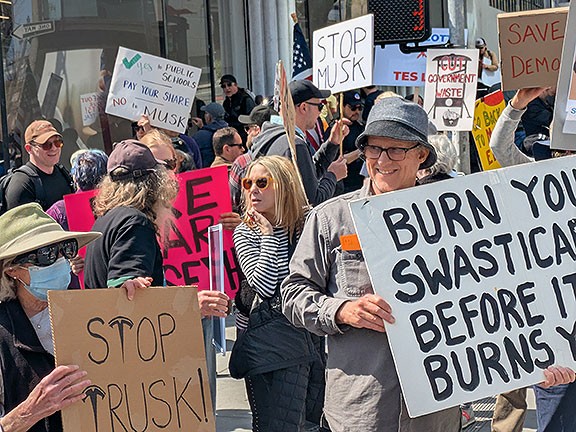
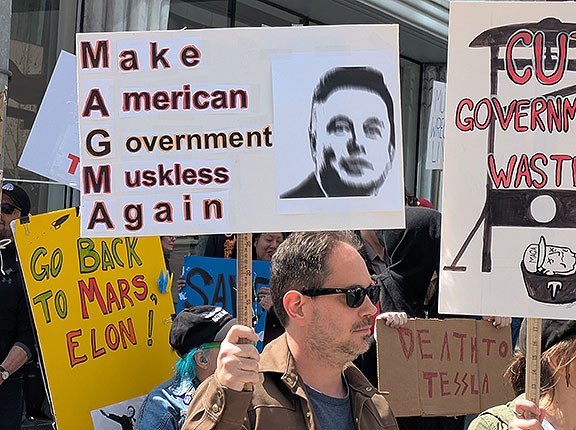
Not always the most radical or politically interesting themes, but anything we do to puncture the myth of the grifter class of kleptocrats seems like worth doing…
 Democracy Wall, January 2025. I’ve spent a lot of years writing about work, technology, revolution, organizing, politics, etc. From the early days of Processed World (1981-1994) to my book Nowtopia (2008) and in dozens of essays on this blog and on Foundsf.org, I’ve addressed how the shape and control of work is the linchpin of how we live, of how we make life together. As I dug into history I realized that it was more than a century ago when a key battle was lost: who decides what kinds of technologies we use, why, and to what purpose? Who decides what work we do, how we do it, how the benefits of our efforts are distributed, and what should we do going forward? It is obvious that nothing remotely resembling a democratic process exists for any of these questions. And yet most people, if asked (which we never are!), would probably agree that a democratic process would be appropriate when it comes to determining the texture and purpose of our lives.
Or as Jathan Sadowski puts it in his new and very valuable book The Mechanic and the Luddite: A Ruthless Criticism of Technology and Capitalism
… risk governance transforms the public into janitors cleaning up the messes of corporations, militaries, police forces, and others who would rather shoot first and never ask questions later. The default is to allow capital to innovate without needing to ask for permission—or at least to move forward with as few imposed guardrails as possible. (p. 166)
As I learned of the long and admirable history of labor agitation and organizing, with its many epic battles and violent confrontations, I concluded that unions as we know them are as much as part of the problem as any other institution in our society. Not because the unions are guided by bad people (though too often they are!), or even that the urge to unionize itself is misguided. I’m in favor of people getting organized!
But the logic of AFL-CIO trade unionism, born in the 1935 Wagner Act and massively curtailed by the 1947 Taft-Hartley Act and ensuing McCarthyite Red Scare, is to narrow union goals to contractual agreements on wages and benefits, and to ensure a base line of safety standards for workers. (Not that the miserable condition of workplace safety and health across U.S. factories, refineries, offices, campuses, and highways is anything to be proud of!) But unions agreed to let owners of capital decide how to organize factories, which technologies to implement, etc., during bitter 19th century battles between capital and labor—when capital had all the power of the state and its police and military, in addition to private armies, at its disposal in that class war. In the recent past unions have capitulated to decades of neoliberal cutbacks, deindustrialization, automation, globalization, and ultimately presided over their own political demise, unwilling to break out of the legal shackles that prevent workers from exercising the power they (should) have over economic life. For all its limitations, the unionization wave of the 1930s was at least based on widespread workplace occupations, secondary strikes and picket lines, boycotts, etc. All those effective techniques were specifically made illegal by Taft-Hartley in 1947.
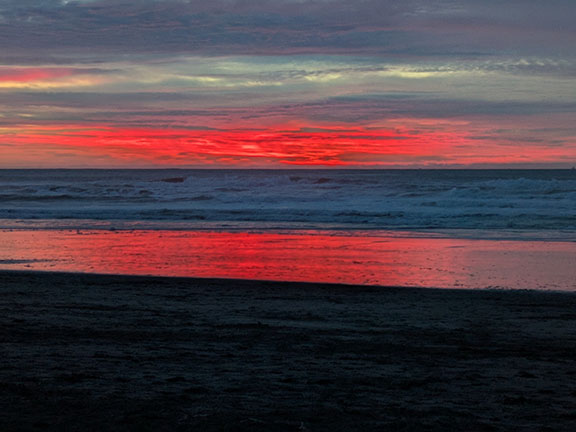 New Year’s Eve, Ocean Beach, Dec. 31 2024 If such militancy still existed and could prevail against the inevitable repression that the state and corporations would bring to bear, it’s still not clear that the working class, or its representative institutions, have much desire to wrest control over decisions about technology, production, or the very structure of the economy from the Lords of Capital. Perhaps with the coming disruptions that the Trump regime will impose on business, government, international borders, etc., not to mention the expected all-out assault on nonprofit organizations and anyone with even the vaguest of center-left politics, social opposition and revolt will be thrown back to basics. That is, finding power where it exists and can be wielded, at work, on the roads, at chokepoints throughout the just-in-time global economy. Once people begin to assert themselves in that direct way again, assuming they do, it’s long overdue to take up the deeper predicament we face over a profoundly unjust and uncontrollable technosphere, one that is using all the tools of behavior modification to keep people down and blaming each other for a fucked up capitalist world.
In the three books I’m going to discuss in this post, a process is unveiled starting with early industrialization at the beginning of the 1800s that has made the introduction of new technologies remarkably undemocratic. Technologies chosen by vested interests to protect and expand their power and wealth are trotted out as inventions and innovations but at no point are everyday people given a chance to evaluate the purpose, value, or potential consequences (good or bad)—not even elected representatives in government are given the opportunity. Any effort to address the consequences of a given technology or invention, no matter how life-altering it turns out to be, are well after the fact and treated by some as illegitimate regulations or impediments to their ability to profit freely. Obviously the current “large language model” system of artificial intelligence (AI) is a good example of a potentially powerful implementation of new software that might have far-reaching consequences in multiple areas.
In Happy Apocalypse: A History of Technological Risk the French historian Jean-Baptiste Fressoz provides a very useful look back at key technological introductions and the social conflicts that arose in the early 1800s. He helpfully frames his discussion with the term disinhibition by which he means two sides of the social integration of new technologies: contemplating danger and then normalizing it. He uses several key examples to show how regulations and safety standards and governmental authorizations were all used to legitimize technological faits accomplis, or technologies that were already being used, regardless of their demonstrably negative or risky qualities.
From a historiographical point of view, his work is doubly interesting because he is seeking to give voice back to the losers of history, to “reconstruct frameworks of intelligibility that their defeat rendered invisible. In so doing, it becomes clear that the opponents of these projects were not siding against innovation, but rather for their environment, their safety, their jobs, and for the preservation of forms of life they considered valuable.” (p. 8) Jathan Sadowski describes the way technologies are actually implemented in the 21st century: “Rather than a politics of refusal, we are given an ethics of acceptance. The driving concern is: How do you get people to trust a technology, integrate it into their lives, or just look the other way and not raise a fuss?” (p. 45)
The Luddites in the 1810s in England are the best example of a dynamic and widespread revolt against new looms and spinning machines that they knew would make their lives worse. No other group or movement has had a bigger impact historically on the question of technology and its social acceptance than the Luddites. Sadowski quotes the great historian of technology and labor processes David Noble saying, “the Luddites were perhaps the last people in the West to perceive technology in the present tense and to act upon that perception.” (p. 43)
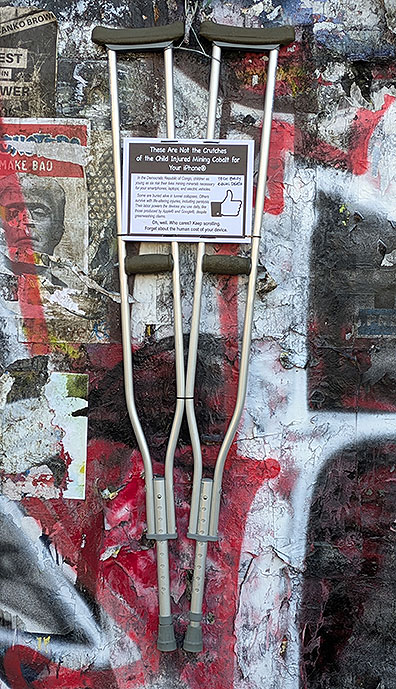 Someone has begun doing 3D art on Democracy Walll… the sign follows at a readable size. 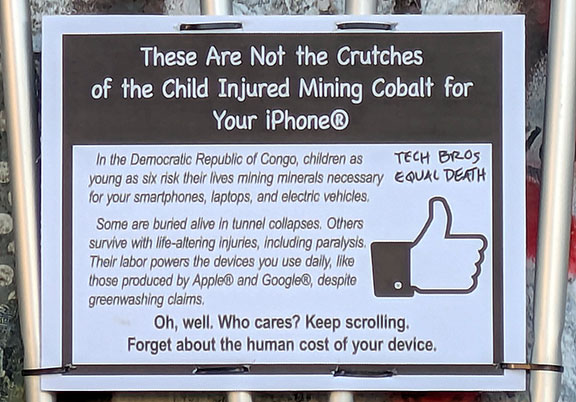
Continue reading AI, Risk, and Work
So said Ralph Waldo Emerson in the middle of the nineteenth century. As we proceed into the glowering gloom of the coming years, I always find it helpful—if not refreshing exactly—to place things in historic context. But also to recognize that there have been deep systemic paradigm shifts again and again—and those shifts don’t come at predictable times, and don’t have predictable effects, either at their moment of eruption, or as time passes and the “new knowledge” begins to percolate through other disciplines, other epistemological frameworks.
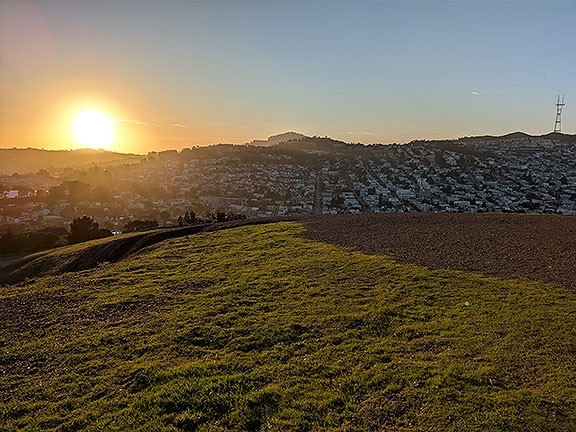 Sun setting in the west from Bernal Heights on Christmas Day, 2024. As usual I’ve been reading a lot, and seven books will get a quote or a mention in this post. I absolutely loved The Light Eaters: How the Unseen World of Plant Intelligence Offers a New Understanding of Life on Earth by Zoë Schlanger. Schlanger’s work contributes to a widening realization that our ideas of intelligence and communication are being radically revised. She spends a bit of time at the start of her book lamenting the role of the 1970s bestseller Secret Life of Plants for casting a long shadow over research into plant sentience and communication. That silly book took my generational cohort by storm and led actual scientists to distance themselves from any connection with such research. But Schlanger, who writes beautifully in addition to plumbing a wide variety of sources, makes it clear that a new sensibility is emerging. She visits labs where plant sentience is being researched and has the opportunity to watch as a clamp sends signals cascading throughout a plant from the spot where it is attached. She even discusses the work of Monica Gagliano, a plant scientist who showed that pea plants have the ability to follow water even in conditions of extreme isolation. Gagliano has since written about her experiments with psychedelics and insights she gained through such journeys, which has put her outside the boundaries of “real science” as maintained by those who police such borders. I wrote enthusiastically about Gagliano in a previous post “Plants are People, Too!” Here is Schlanger, helping to describe why the borders of our knowledge are in flux:
In 2012, a group of scientists gathered at the University of Cambridge to formally confer consciousness on all mammals, birds, and “many other creatures, including octopuses.” Nonhuman animals had all the physical markers of conscious states, and clearly acted with a sense of intention. “Consequently, the weight of evidence indicates that humans are not unique in possessing the neurological substrates that generate consciousness,” they declared. (p. 41)
… plants could be said to have dialects, and are alert to their contexts enough to know when to deploy them. More than that, they have a clear sense of who is who; who is family, and who is not. They are in touch with their surroundings, and with the fluctuating status of their enemies. Their communication is not just rudimentary but complex and layered, alive with multiple meanings. (p. 66)
This all the more remarkable when you think about how hard our new Know Nothing (Own Everything) political and business leaders are doubling down on the false promise of Large Language Model-based “artificial intelligence,” which is demonstrably NOT intelligent in any meaningful sense of the term. Coming from a metaphysical angle to contemplate relationships between animate and inanimate worlds, Meghan O’Gieblyn (who I originally heard on the Tech Won’t Save Us podcast) writes in her fascinating meditative work God Human Animal Machine: Technology, Metaphor, and the Search for Meaning
In the end, transhumanism and other techno-utopian ideas have served to advance what [Jaron] Lanier calls an “antihuman approach to computation,” a digital climate in which “bits are presented as if they were alive, while humans are transient fragments.” (p. 75) … But to blame the whole history of disenchantment on human egotism seemed too easy, and perhaps even at cross-purposes with what these new theoretical frameworks were trying to achieve. The discourse too often arrived at the strange conclusion that conceiving of the world, once again, as intelligent and alive would require renouncing those very qualities in ourselves. (p. 90)
Writing a few posts ago about Grove’s Savage Ecology led me to plumb his footnotes a bit and William Connolly came up a lot, apparently a mentor of sorts. He’s a prolific contemporary philosopher so it wasn’t easy to read his monograph Climate Machines, Fascist Drives, and Truth, but as a once-upon-a-time philosophy student I found my way. These same kinds of groping ruminations about where the boundaries are between different forms of intelligence, of life, of knowing, seep through his work too. In this longish quote he starts with Erasmus and ends with Sophocles (or is that Robert Johnson?):
Erasmus was impressed with what today would be called the self-organizing processes in species evolution. In such an image, the strivings of multiple intersecting entities, such as mutations, bacteria, and embryos, periodically enter into resonances with one another. Occasionally a new species emerges out of those that is irreducible to the simple replication of mutations alone. Evolution as self-organizing processes often enough includes horizontal processes exceeding the vertical processes involved in sexual relations.
Such an image of species evolution encourages less hubristic practices of science than those advanced today by proponents of climate geoengineering, cloning, nuclear physics, behavioral social science, neo-Darwinism, and—most generically—the pursuit of human mastery over a docile earth. It rather encourage scientists to watch and study life forms to gauge the multiple strivings, resonances, horizontal intersections, and bifurcation points through which evolution proceeds. A bifurcation point issues at least one if and one course actually taken. Sophocles would call it a crossroad. (p. 31)
Continue reading “Things Are in the Saddle, and Ride Mankind”
|
Hidden San Francisco 2nd EDITION!

NEW 2nd EDITION NOW AVAILABLE!
Buy one here
(Pluto Press, Spring 2025)
|













